-
- Why is DLP important?
- What is data loss?
- Understanding data leaks
- What are the different types of data loss?
- What are the different types of data threats?
- What is data leakage prevention?
- What is a data loss prevention policy?
- How does DLP work?
- What is data loss prevention software?
- What are the components of a data loss solution?
- What are the different types of DLP solutions?
- What are the benefits of DLP solutions?
- What are the challenges associated with DLP solutions?
- What are the primary DLP use cases?
- How to successfully adopt and deploy DLP in 7 steps
- What is DLP’s role in compliance?
- 2024 data loss prevention statistics
- 2024 data loss prevention trends
- Top 10 DLP best practices, tips, and tricks
- DLP FAQs
What Is DLP (Data Loss Prevention)? | Guide to DLP Security
5 min. read
Table of Contents
Data loss prevention (DLP) is a cybersecurity strategy designed to prevent the unauthorized access, use, or transmission of sensitive data.
DLP involves monitoring data at rest, in motion, and in use to detect and block potential data breaches. Organizations implement DLP to protect confidential information and comply with industry regulations such as GDPR and HIPAA.
Why is DLP important?
DLP is important because it maintains the integrity and security of sensitive information.
In today’s digital-first world, data is stored in various formats and locations. Which makes it increasingly challenging to keep track of who has access to it and how it’s used.
DLP, which stands for data loss prevention, helps organizations manage these complexities by monitoring data across endpoints, networks, and cloud environments.
In other words:
DLP in cyber security ensures that sensitive information, such as personally identifiable information (PII) and intellectual property, remains protected.
Data breaches are costly, both financially and in terms of reputation. In fact, the average cost of a data breach reached $4.88 million in 2024, according to IBM’s Cost of a Data Breach Report 2024 — and the damage to a company’s brand can persist for years.
It’s been well established that data breaches can have long-term consequences.
We all know they can lead to regulatory fines, loss of customer trust, and even job losses for executives.
Plus: Regulations like GDPR, HIPAA, and PCI DSS require organizations to have rigorous data protection measures in place. And non-compliance can lead to severe penalties.
Data loss prevention controls address these requirements by protecting data and preventing unauthorized access.
However: DLP isn’t just about compliance—it’s about knowing where your data is and ensuring it’s always protected. Which is another reason why DLP is critical—because it provides visibility into how data is stored, accessed, and transmitted.
Visibility helps organizations identify vulnerabilities and manage risks effectively.
An effective DLP solution helps detect and prevent both accidental and malicious data breaches. DLP is an essential part of any risk reduction strategy.
What is data loss?
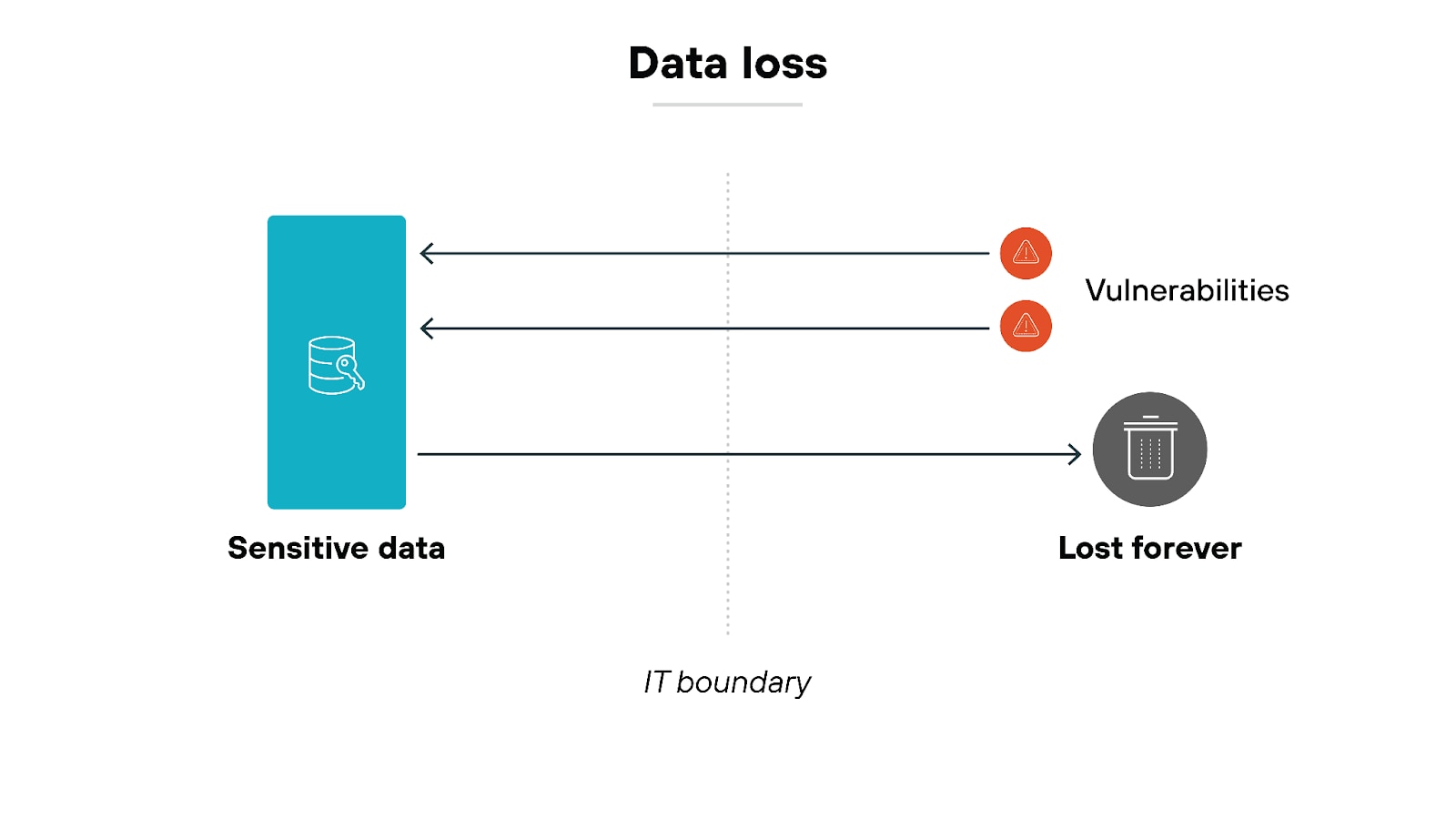
Data loss means losing access to critical information, either permanently or temporarily.
It happens when valuable or sensitive information is destroyed, erased, or made inaccessible. Data loss can occur due to many reasons, such as human error, hardware failure, cyberattacks, or natural disasters.
More specifically, data loss can be caused by both internal and external factors. Human errors, ranging from misconfiguring cloud storage permissions to failing to apply proper data encryption when transferring corporate data, are very common causes.
Cyberattacks, like ransomware or DDoS attacks, can also lead to data loss by encrypting or destroying information.
Note: Data loss differs from data breaches. In a data breach, information is accessed by unauthorized individuals, but the data itself is not necessarily destroyed. Data loss, however, involves the destruction or corruption of the data, making it unusable.
This is why backing up important data is so crucial—it’s often the only way to recover lost information.
Data loss prevention solutions address these issues by preventing unauthorized access, accidental deletion, or malicious destruction of data.
Understanding data leaks

A data leak is when sensitive information is unintentionally exposed to unauthorized individuals.
Unlike data breaches, which often involve malicious attacks, data leaks are usually the result of internal errors or inadequate security practices. In other words: Data leaks occur when someone who shouldn't have access to the information ends up seeing it.
Here’s why data leaks happen.
Sometimes, a data leak is a simple mistake, like an employee leaving a database unsecured. Other times, it’s due to outdated systems or misconfigurations that allow data to be accessed by unintended users. Negligent handling of sensitive information—like using unsecured public networks—can also lead to data leaks.
While data leaks are often unintentional, the consequences can be severe.
Exposed information can include anything from personal data, like social security numbers, to proprietary business information.
Obviously, if this data ends up in the wrong hands, it can lead to identity theft, financial loss, or even data breaches.
Here’s why data leaks are such a significant issue:
Because they make sensitive information vulnerable.
Data loss prevention solutions play a crucial role in addressing this problem. They help monitor and secure data, ensuring that it doesn’t end up where it shouldn't.
Note: Data leaks are distinct from data loss. Data leaks involve the unintended exposure of sensitive data to unauthorized individuals, often due to internal errors or poor security practices. Unlike data loss, which involves the destruction or inaccessibility of data, data leaks do not necessarily destroy data but instead make it visible to those without proper authorization, potentially leading to data breaches.
What are the different types of data loss?
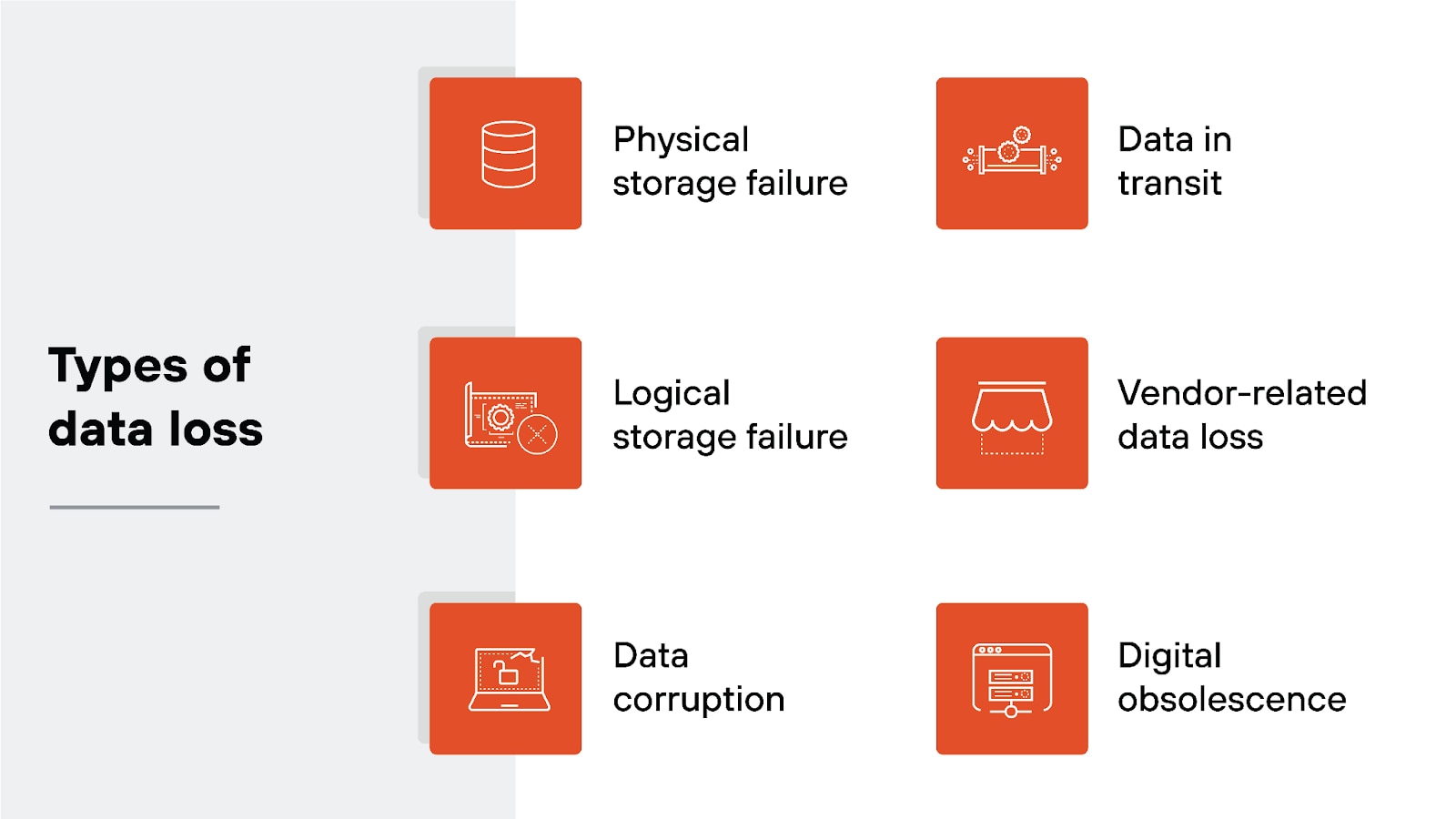
Data loss can take many forms, including:
- Physical storage failure
- Logical storage failure
- Data corruption
- Data in transit
- Vendor-related data loss
- Digital obsolescence
Each type of data loss has unique causes and challenges. Understanding these types helps organizations protect their information effectively.
Let’s break down the different ways data can be lost.
Physical storage failure
First, there’s physical storage failure. This happens when hardware, like a hard drive or a laptop, stops working.
Physical damage or mechanical failure can make data inaccessible. In some cases, data can be recovered, but it’s always better to prevent physical damage before it happens.
Logical storage failure
This type of data loss occurs due to software issues or human error.
For example: A software glitch might make the data unreadable, or someone might accidentally delete important files. The data might still exist on the device temporarily, but it can be difficult to recover without immediate action.
Data corruption
Another common type is data corruption. This happens when information gets altered in a way that makes it unusable.
It can occur during storage, transmission, or processing. Data corruption is often caused by software errors, malware, or even improper formatting.
Data in transit
Data in transit is also vulnerable to loss. When information is transferred from one location to another, it can be lost or corrupted during the process.
This might happen due to network issues, server crashes, or storage problems during the transfer.
Vendor-related data loss
We also have vendor-related data loss. This happens when a vendor that holds your data becomes unavailable.
For instance: If a service provider goes out of business or if you close an account with them, you could lose access to your data.
Vendor issues can also occur if the provider suffers a data breach or other security incident.
Digital obsolescence
Finally, there’s digital obsolescence. This occurs when a storage medium becomes outdated, making it impossible to access the stored data with current technology.
For example: Older media like floppy disks might require special tools to access. To prevent this, it’s important to regularly update storage formats and maintain backups.
What are the different types of data threats?
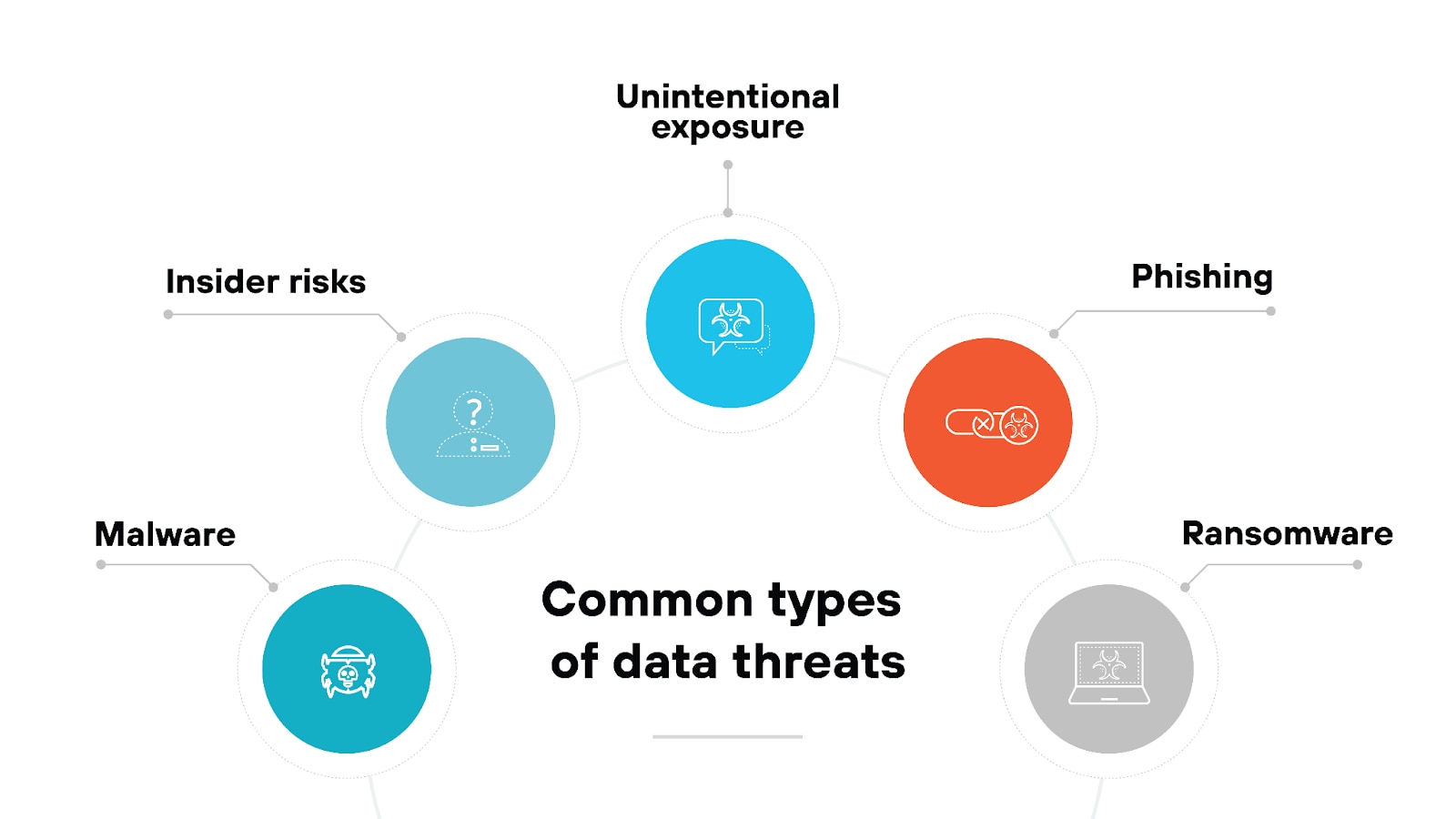
Data threats come in many forms, each posing a unique risk to the confidentiality, integrity, and availability of sensitive information.
Common types of data threats include, but aren’t necessarily limited to:
- Malware
- Insider risks
- Unintentional exposure
- Phishing
- Ransomware
Let’s take a look at each in more detail.
Malware
Malware is malicious software designed to damage, disrupt, or gain unauthorized access to systems. It includes viruses, worms, and spyware.
Malware is often disguised as a trusted attachment or file, which, when opened, can compromise your entire network.
Insider risks
Insider risks come from individuals within the organization who misuse their access to data. These can be current or former employees, vendors, or contractors.
Whether intentional or accidental, insider risks can have severe consequences if data is leaked or mishandled.
Unintentional exposure
Unintentional exposure occurs when sensitive data is accidentally made accessible to unauthorized users.
This often happens because of inadequate security practices or misconfigurations. Employees might unknowingly leave databases open or share files without proper protections.
Phishing
Phishing is a social engineering tactic where attackers trick people into revealing personal information.
These fraudulent emails or messages appear legitimate but aim to steal data like passwords or credit card numbers.
Phishing can target individuals or entire organizations.
Ransomware
Ransomware is a form of malware that encrypts data and demands a ransom to unlock it. This type of attack can lead to both data loss and significant financial costs.
It’s particularly challenging because attackers use sophisticated methods to infiltrate networks and hold data hostage.
What is data leakage prevention?

Data leak prevention, sometimes referred to as data leakage protection, is a cybersecurity approach focused on stopping sensitive information from being unintentionally or intentionally shared with unauthorized individuals or systems.
The goal is to ensure that confidential data, such as personal information, financial records, or trade secrets, remains within the organization and does not leak to external parties.
In other words, data leak prevention is about keeping your data where it belongs.
Data leaks can happen in many ways.
For example(s):
- Sensitive information might be leaked through emails, file-sharing services, or even physical documents.
- Employees might accidentally send an email with confidential information to the wrong person.
- Or they could leave a cloud storage folder publicly accessible without realizing it.
- Malicious insiders might deliberately share information with external entities.
Note: Data leak protection is distinct from data loss prevention. While both focus on safeguarding sensitive information, data leakage prevention specifically aims to prevent unauthorized outbound data transfer. Data loss prevention, on the other hand, has a broader scope—protecting data from being lost or destroyed entirely, whether due to accidents, hardware failure, or deliberate attacks.
What is a data loss prevention policy?
A data loss prevention policy outlines the procedures and guidelines that an organization uses to protect its sensitive data from unauthorized access, leakage, or destruction.
It serves as a foundational element in ensuring that data is managed responsibly and securely. Essentially, a data loss prevention policy is the roadmap that guides the organization in keeping its data safe.
This is what a DLP policy defines:
- The types of data that need to be protected, such as PII, intellectual property, or financial records.
- It also lays out the protocols for how this data can be accessed and shared, and by whom. Policies may include rules for encryption, data access controls, and regular audits to make sure data security measures are in place and working as intended.
- Importantly, a DLP policy also specifies the actions to be taken in case of a security event. This means having a plan for detecting potential data breaches, mitigating risks, and recovering any lost data. The goal is to make sure that any incident is handled effectively to minimize damage.
Here’s what a DLP policy might look like:
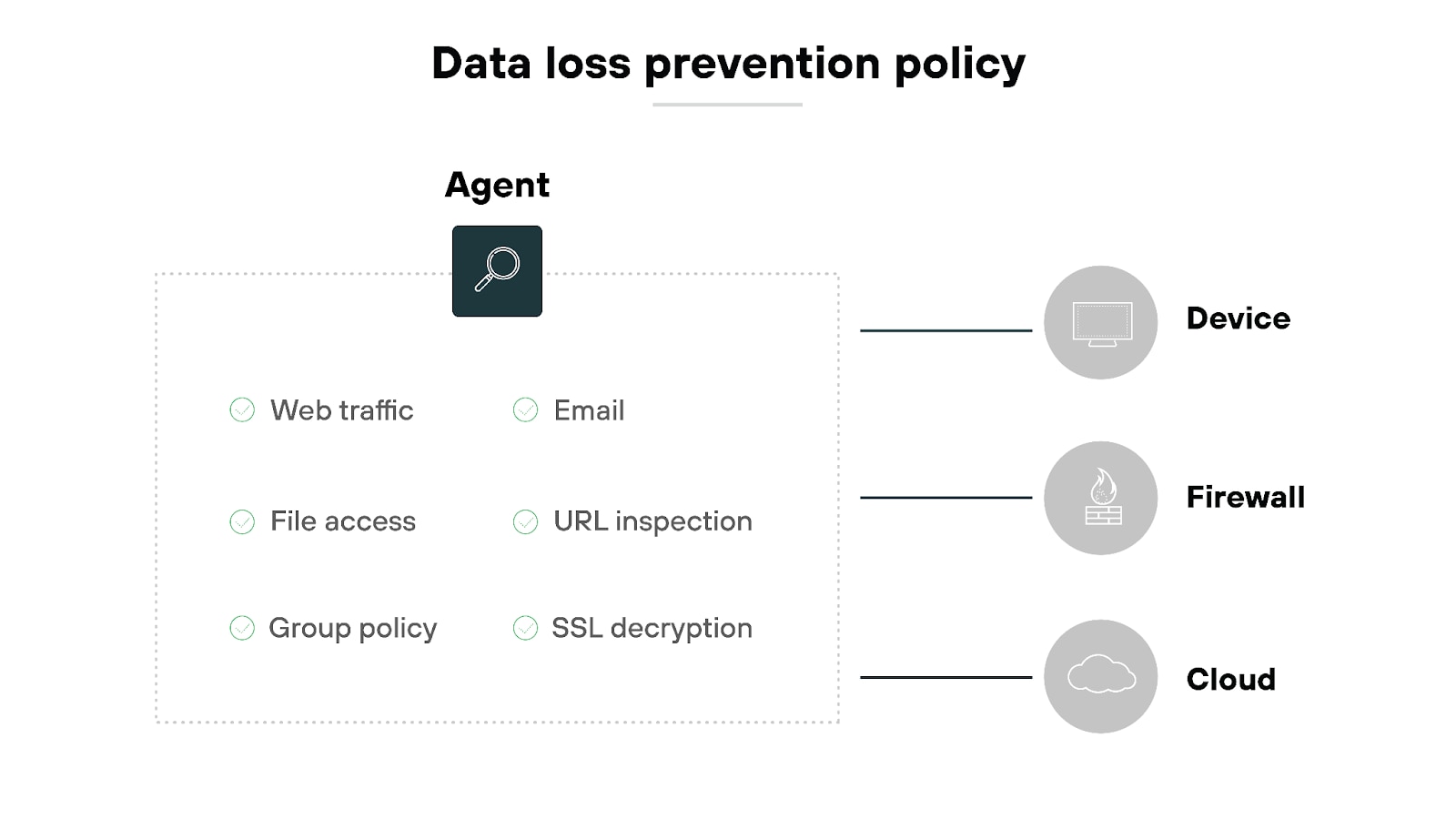
A DLP policy fits into DLP implementation by effectively acting as the backbone.
Without clear DLP policies, it's difficult to enforce consistent data protection across the organization. DLP tools are configured based on the rules set forth in the policy.
They help monitor, detect, and enforce the guidelines, making sure that data is only accessed and used in ways that comply with the established standards.
How does DLP work?
(DLP) works by using a combination of technologies, processes, and policies to protect sensitive information.

DLP works according to a five-step process which involves:
- Discovering and identifying data
- Classifying data
- Continuously monitoring data
- Taking action when violations are detected
- Ongoing documentation and reporting
First, it involves discovering and identifying data—using tools that scan endpoints, cloud environments, and networks to detect where sensitive data is stored.
Then, it classifies data according to its sensitivity, ensuring that the appropriate level of security is applied based on factors like content type and regulatory requirements.
Next, DLP solutions continuously monitor data as it moves, is accessed, or is used within the organization. For example: It might track emails, file transfers, and even documents copied to external drives. During monitoring, DLP tools compare data activities against set policies to identify any potential breaches or abnormal behavior. This includes methods like deep content analysis, pattern matching, and data fingerprinting.
If a violation is detected—such as unauthorized data access or an attempt to transfer data externally—the DLP solution takes action. This might involve encrypting the data, blocking the transfer, or sending an alert to security personnel. In some cases, additional security challenges or alerts to the user may be used to ensure compliance.
Finally, documentation and reporting play a key role. DLP solutions often include dashboards that provide insights into data activities and any incidents that occur. This helps security teams refine policies over time, ensure compliance with data protection regulations, and provide an audit trail for reviewing any incidents or threats that were identified and mitigated.
What is data loss prevention software?
Data loss prevention software is a set of tools designed to protect sensitive information by detecting and preventing unauthorized access or transmission.
As established, DLP tools work by classifying data, monitoring activity, and ensuring that data is only used in ways that align with an organization's data protection policies. Again, DLP software is like the gatekeeper that ensures your data stays safe and secure.
In the market, you will find two types of DLP software: dedicated and integrated.
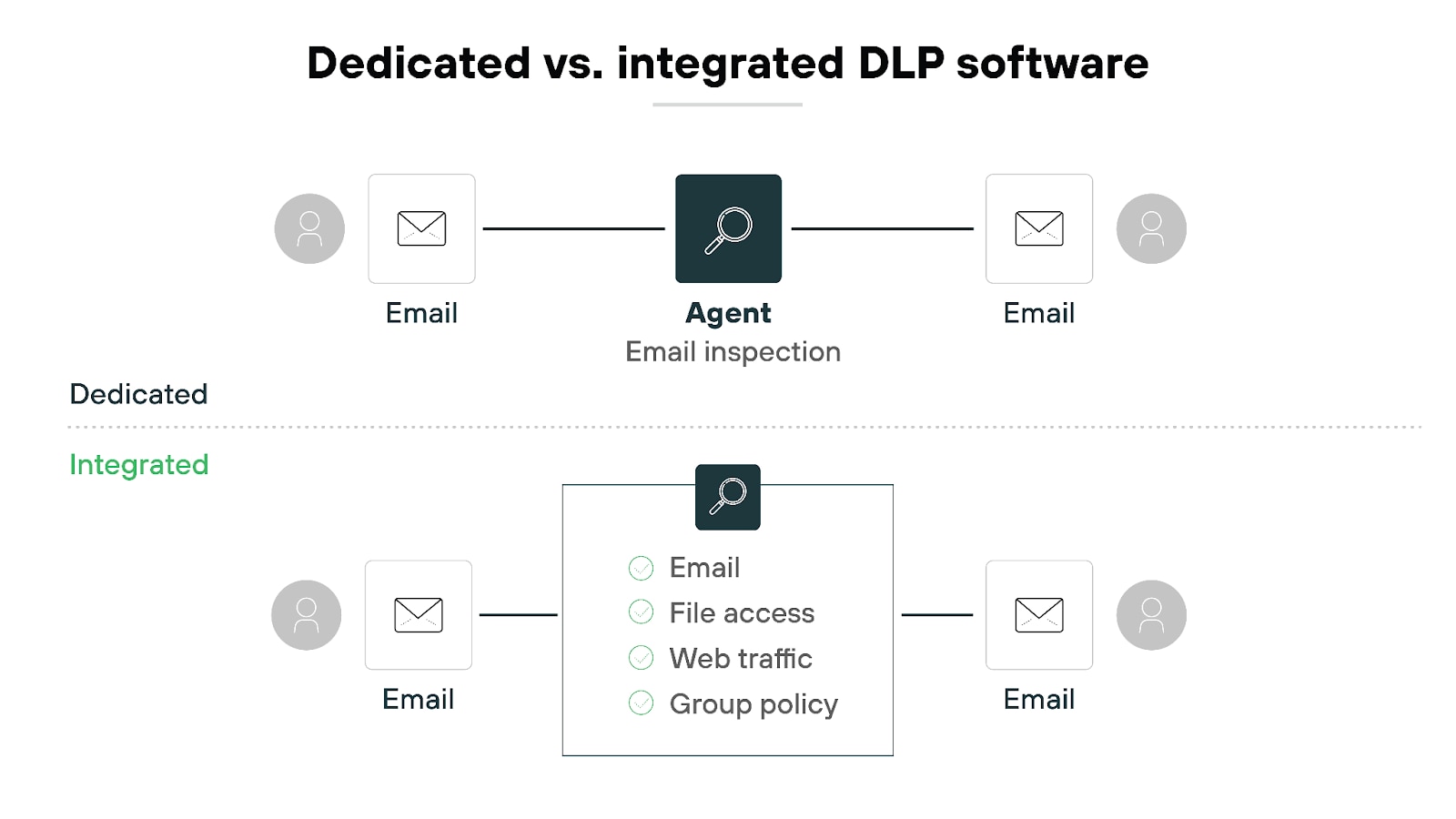
Dedicated DLP solutions focus exclusively on DLP and offer in-depth features.
Integrated DLP solutions, on the other hand, combine DLP capabilities with other security tools, offering a more streamlined but less specialized approach.
The right solution depends on your organization's specific needs and risk profile.
What are the components of a data loss solution?
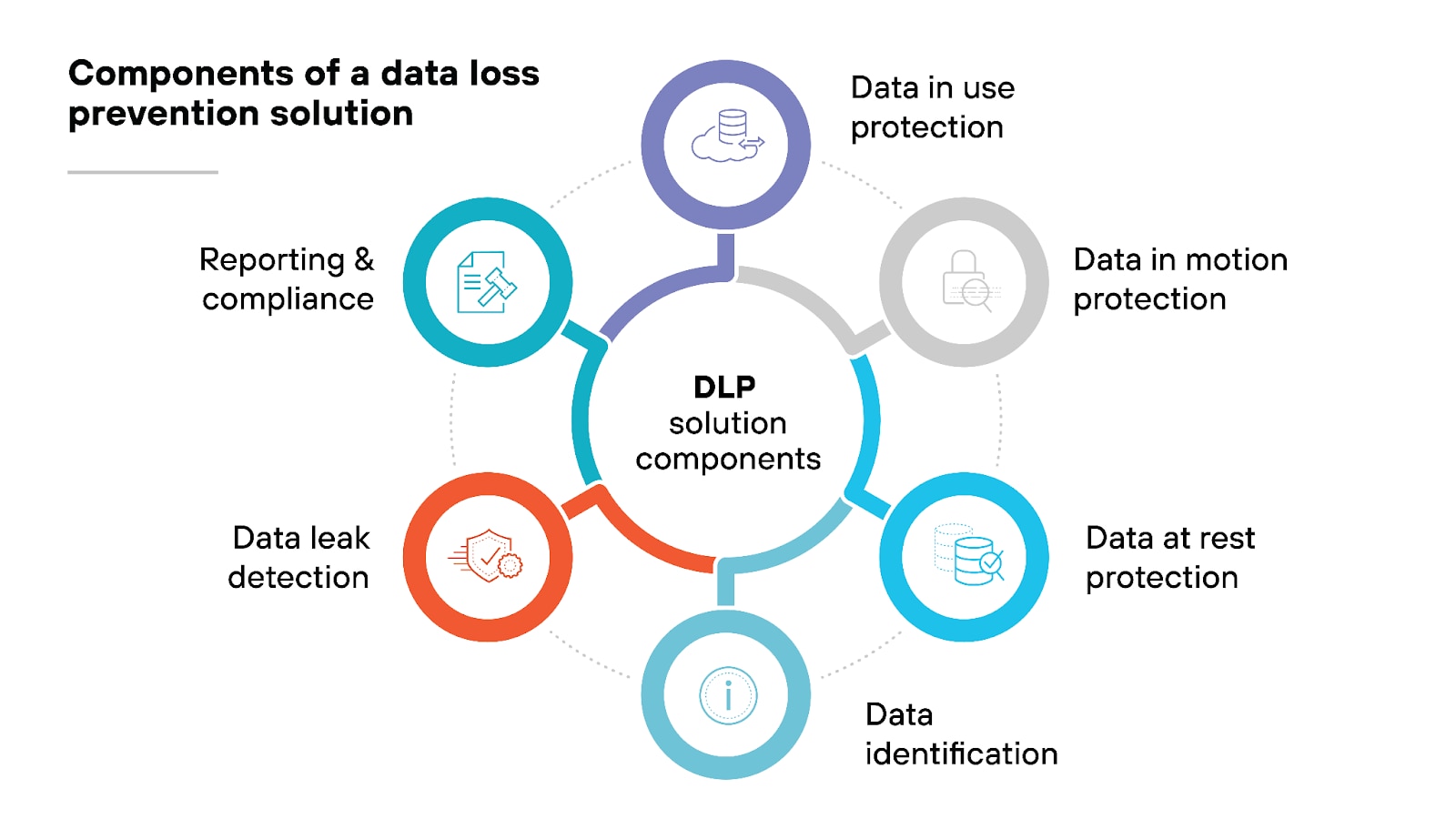
A comprehensive data loss solution has several components that work together to protect sensitive information.
These components help secure data at every stage, whether it is being accessed, shared, or stored.
Let's break down the capabilities that make up a robust data loss solution:
- Data in use protection
- Data in motion protection
- Data at rest protection
- Data identification
- Data leak detection
- Reporting and compliance
Securing data in motion
The first component is securing data in motion. This means protecting sensitive data while it is being transmitted across a network.
Tools installed at the network edge can analyze traffic, detect sensitive information being sent in violation of security policies, and take action to prevent unauthorized sharing.
Encryption is often used here to ensure data remains safe during transmission.
Securing data at rest
Another critical part is securing data at rest. This refers to protecting data that is being stored, whether on local servers, cloud environments, or other storage solutions.
Techniques like encryption, access control, and data retention policies are used to keep archived data safe and restrict access to only those who are authorized.
Securing data in use
Securing data in use is also an important element of a data loss solution. This involves monitoring data as it is being accessed and used by employees.
DLP tools can flag unauthorized activities, such as copying or modifying sensitive data, and prevent actions that pose a risk to the organization. This ensures that even while being actively handled, data remains protected.
Data identification
Data identification is another key component. Before data can be secured, it must be classified as sensitive.
This classification can be done manually by applying rules and metadata, or automatically using machine learning techniques that identify patterns. Proper data identification makes it easier to apply the correct security measures.
Data leak detection
Finally, data leak detection plays a crucial role in a DLP solution. This means monitoring for any suspicious data transfers or unusual activity.
Integrated with systems like intrusion detection and prevention systems (IDS/IPS) and security information and event management (SIEM), DLP tools can alert security staff to potential data leaks and help them respond swiftly
Note: DLP software also provides valuable reporting capabilities, which help organizations meet regulatory compliance requirements, identify vulnerabilities, and respond to incidents effectively. These insights are crucial for enhancing data security practices and making sure that sensitive data stays protected over time.
What are the different types of DLP solutions?
There are several types of DLP solutions available:
- Network DLP
- Endpoint DLP
- Cloud DLP
- Email DLP
Each type has a specific focus, depending on where and how data needs to be protected. Understanding these types helps organizations choose the right mix of solutions to effectively protect their sensitive information from unauthorized access or leaks.
Let's explore the main types of DLP solutions and their unique features.
Network DLP
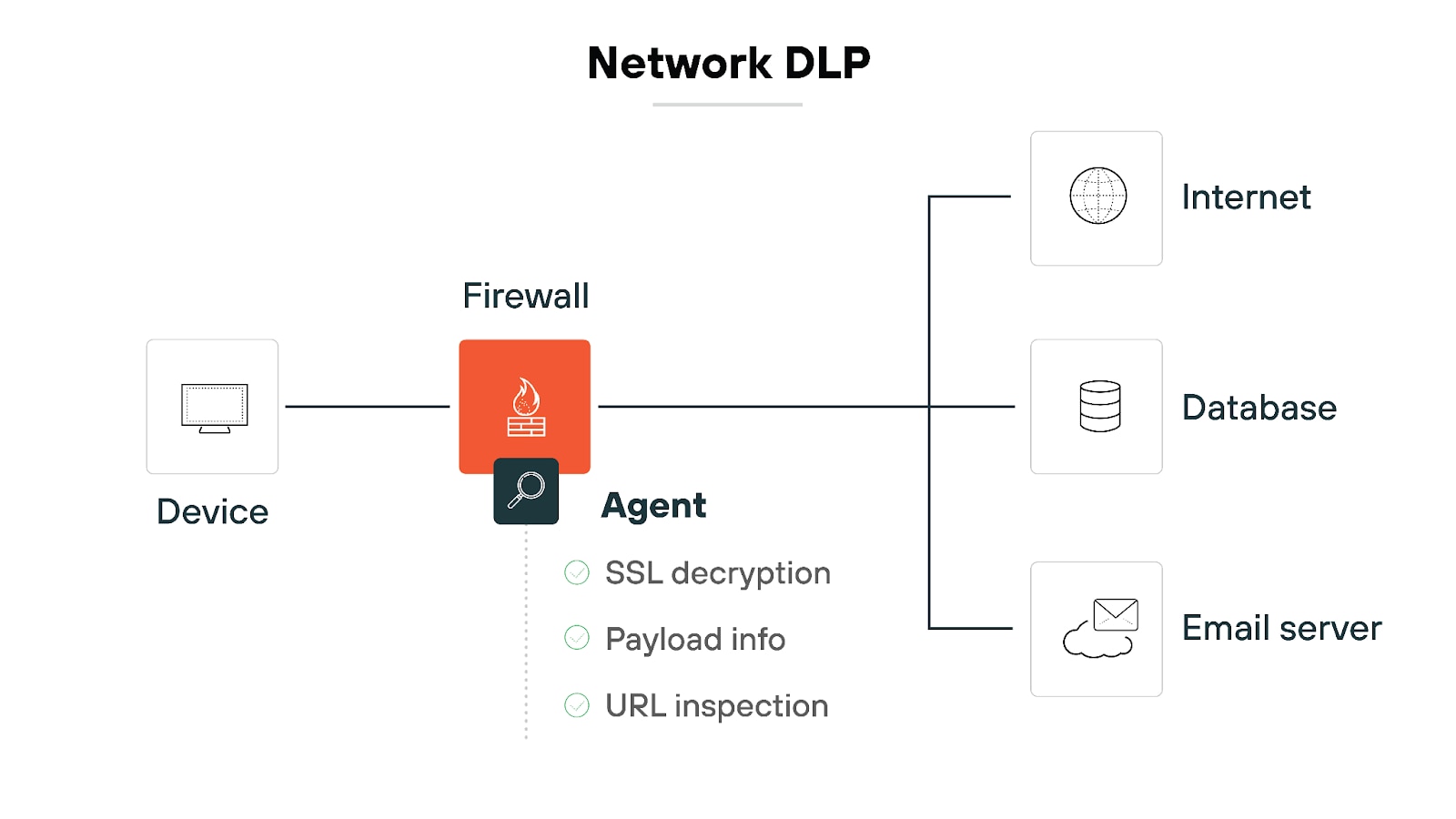
Network DLP solutions focus on protecting data as it moves across an organization's network.
This includes data in transit between internal systems or going out to external locations.
Network DLP tools monitor network traffic, identify sensitive data, and prevent unauthorized data transfers. This approach ensures that sensitive information remains secure while moving through different network channels.
Endpoint DLP

Endpoint DLP solutions protect data on individual devices, such as laptops, desktops, and mobile phones.
These solutions monitor data access and movement at the user level. They can prevent users from copying sensitive data to external storage devices or uploading it to unauthorized platforms.
Endpoint DLP is crucial for ensuring that data stays secure, even when accessed from various devices.
Cloud DLP
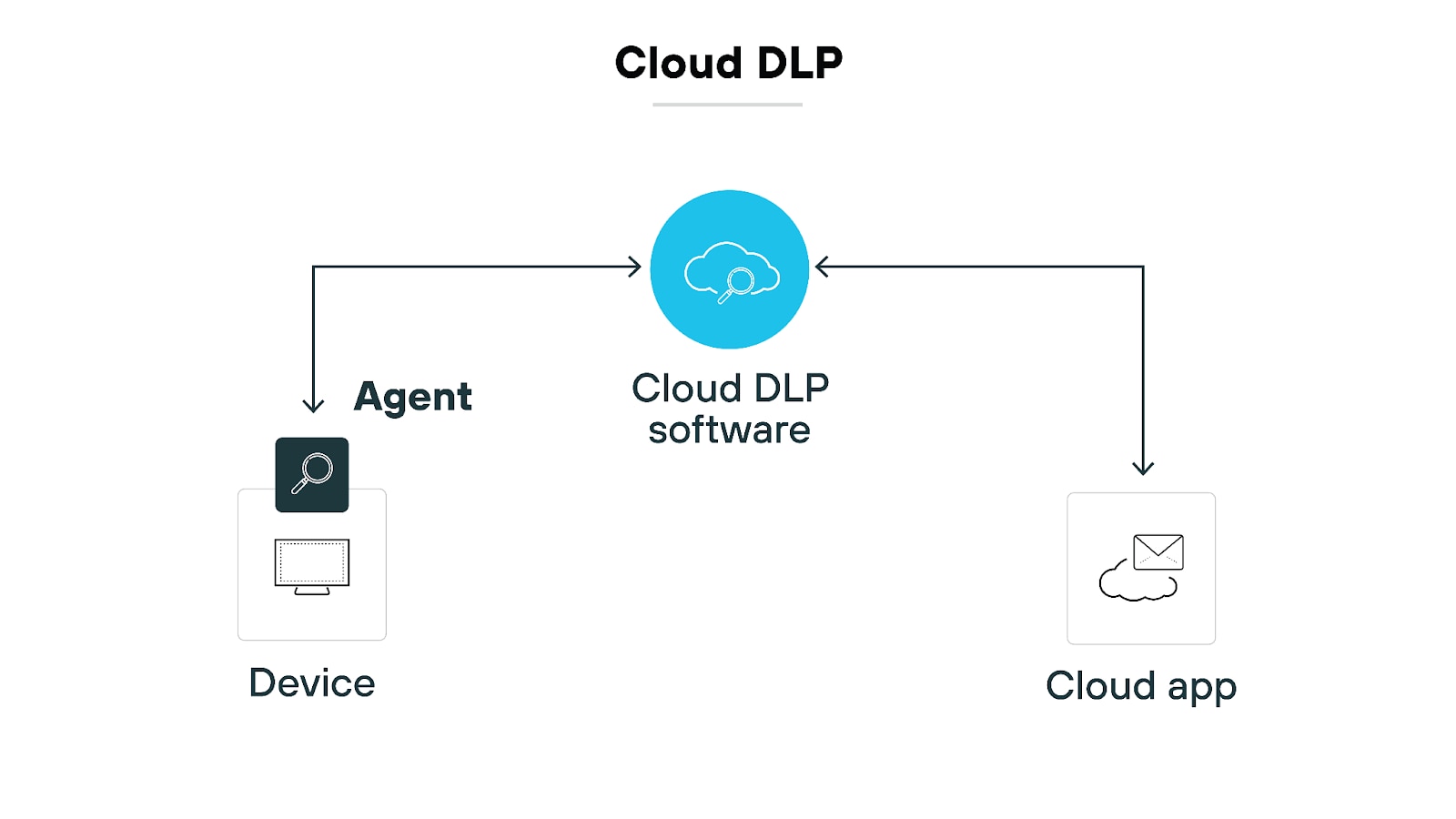
Cloud DLP solutions are designed to protect data stored and processed in cloud environments.
As more organizations adopt cloud-based services, it becomes important to ensure that sensitive data remains protected. Cloud DLP tools help monitor data in cloud applications, like SaaS or IaaS platforms, and enforce security policies to prevent unauthorized access or data sharing.
This type of solution is particularly useful for organizations with significant cloud infrastructure.
Further reading: 3 Problems Cloud DLP Solves
Email DLP
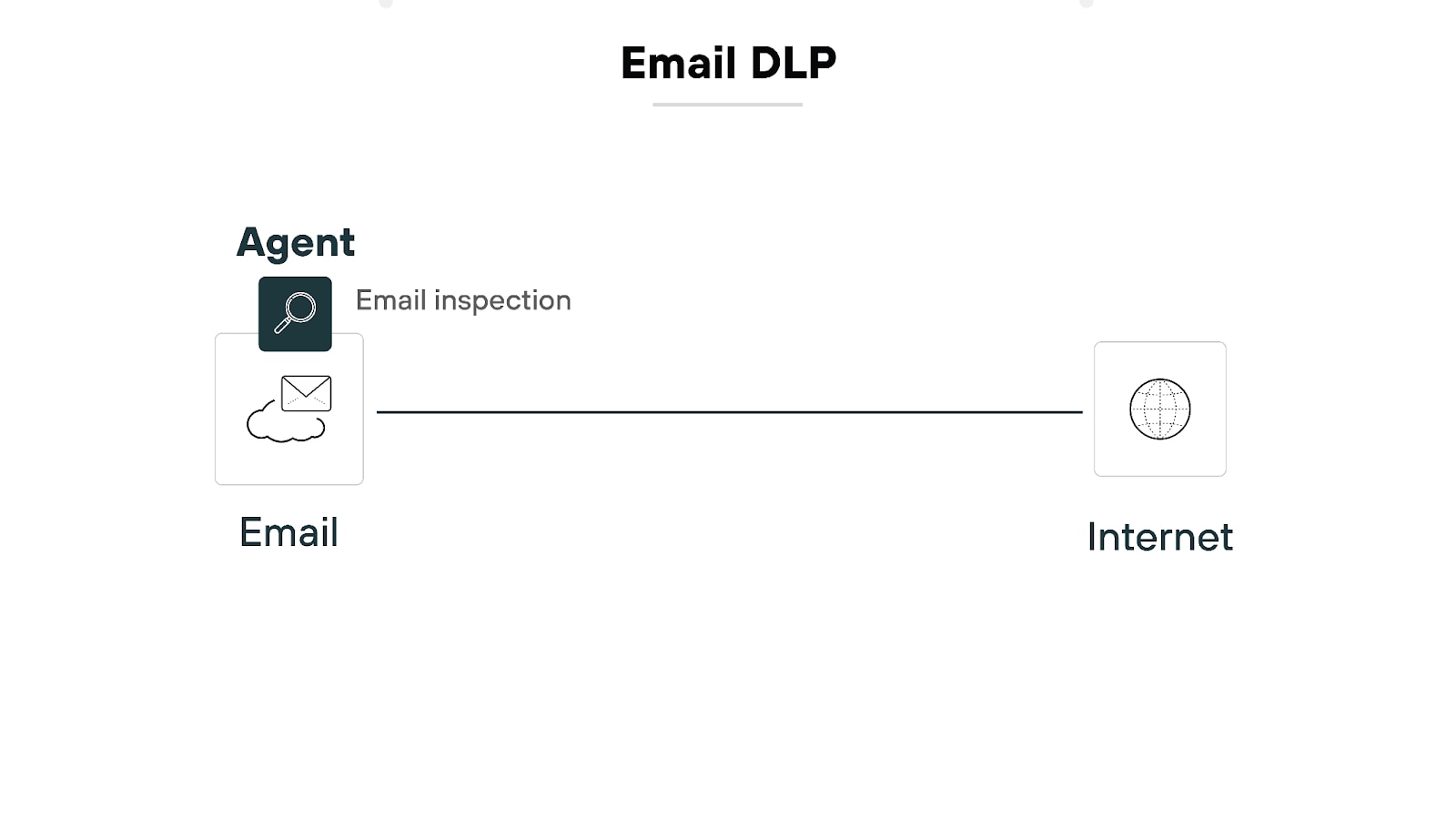
Email DLP solutions focus on securing data sent through email communications. Sensitive information can easily be leaked via email, either accidentally or intentionally.
Email DLP tools monitor email content and attachments to detect any sensitive data being sent outside the organization. By enforcing policies on outbound emails, these solutions help prevent data breaches and maintain the security of communication channels.
What are the benefits of DLP solutions?

DLP (data loss prevention) solutions offer many benefits that can help organizations keep their sensitive data secure, including increased visibility, protection against data breaches, regulatory compliance, automated data classification, and improved incident response.
Implementing a DLP solution not only protects sensitive data but also improves overall security practices
Let’s explore some of the key advantages that make DLP an essential part of modern data security.
Increased visibility
One of the biggest benefits of a DLP solution is increased visibility into data usage.
DLP allows organizations to monitor their data across networks, endpoints, and cloud environments. In other words, it helps you see where your sensitive data is, how it's being used, and who has access to it.
This level of visibility is crucial for effective data governance.
Protection against data breaches
DLP solutions help prevent unauthorized access to sensitive information, which reduces the likelihood of data breaches.
By monitoring data movement and enforcing policies, DLP solutions can detect and block suspicious activities before they become a major issue.
This proactive approach helps organizations avoid the financial and reputational damage associated with data breaches.
Regulatory compliance
Compliance with data protection regulations is a significant challenge for many organizations. DLP solutions help address this by ensuring sensitive data is handled according to regulatory requirements like GDPR, HIPAA, and PCI DSS. The ability to classify, monitor, and report on data makes it easier to meet compliance standards and avoid hefty fines.
Automated data classification
Data classification is an important part of managing sensitive information.
DLP solutions often include automated classification features that categorize data based on its sensitivity. This helps organizations understand the types of data they are handling and apply appropriate security measures.
Automated classification also reduces the risk of human error, making data protection more reliable.
Improved incident response
DLP solutions provide real-time alerts when potential data threats are detected. This allows security teams to respond quickly and minimize damage.
Faster incident response means that data breaches can be addressed before they escalate, helping to protect both the organization and its customers.
What are the challenges associated with DLP solutions?
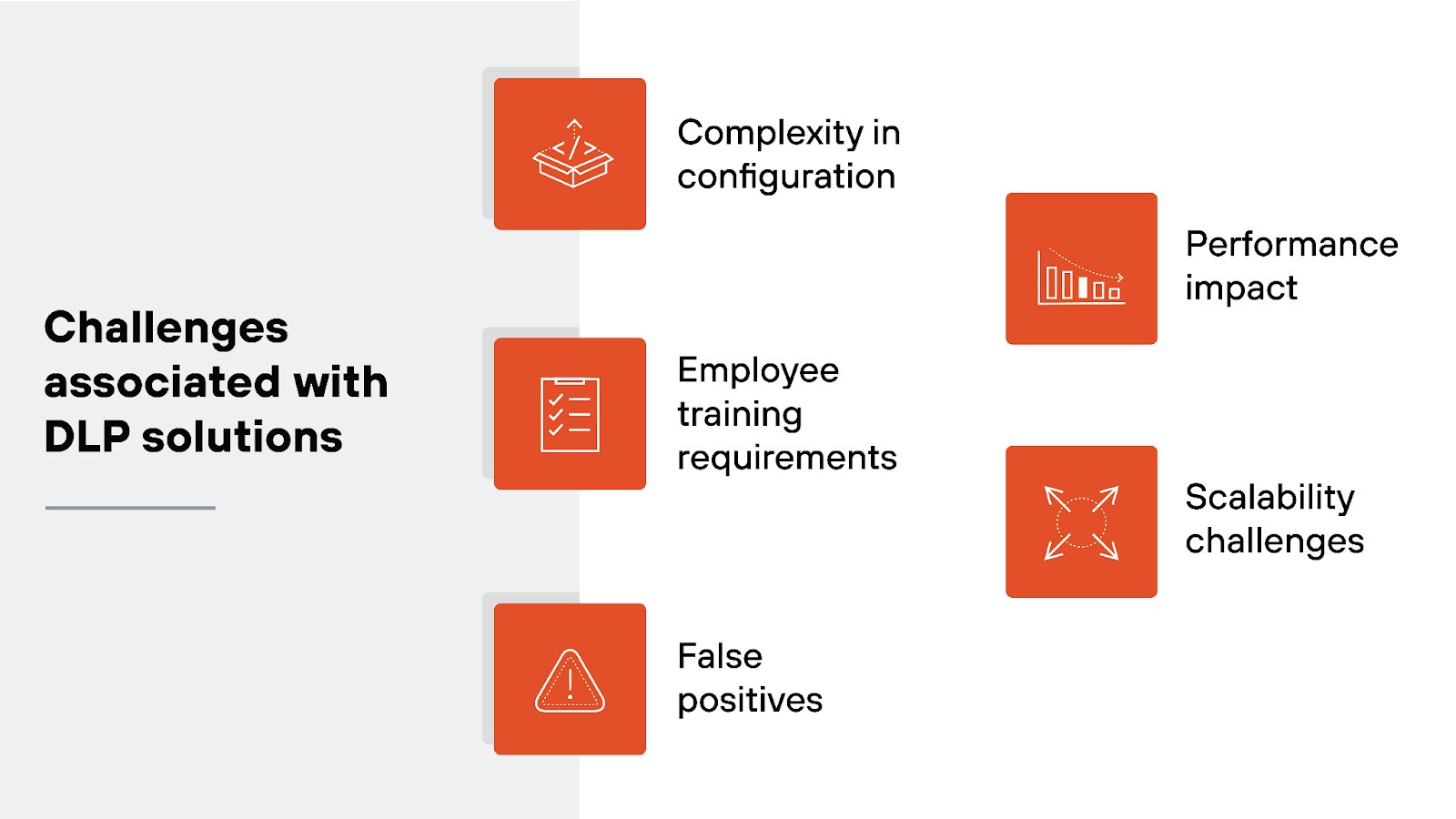
While DLP solutions offer significant benefits, they also come with challenges that organizations need to be aware of—although none that can’t be overcome.
Organizations should plan for these potential hurdles by investing in proper configuration, employee training, and scaling strategies to ensure that the benefits of DLP outweigh the challenges.
Let’s break down some of the key challenges associated with implementing and maintaining DLP solutions.
Complexity in configuration
DLP solutions can be complex to configure and manage, especially in organizations with large amounts of data and numerous employees.
Each user often requires different levels of access, which adds complexity to managing the system effectively. The challenge lies in setting the right policies and ensuring the solution aligns with the organization's specific needs.
Employee training requirements
Implementing a DLP solution requires ongoing employee training.
Employees need to understand how to use the DLP tools properly and comply with data protection policies. This means regular training sessions, which can be time-consuming and costly, especially for larger organizations.
Without proper training, employees may inadvertently undermine the effectiveness of DLP.
False positives
DLP systems can generate false positives, where legitimate activities are flagged as security threats.
This can create unnecessary alerts, leading to alert fatigue among security teams. When false positives are frequent, security personnel may become desensitized to alerts, potentially causing them to overlook real threats.
Performance impact
DLP solutions can affect system performance.
Continuous monitoring of data flow and policy enforcement requires significant processing power, which can place a load on network resources. In environments with limited bandwidth or older hardware, this can lead to slower response times and reduced productivity.
Scalability challenges
As organizations grow, scaling a DLP solution can become challenging. Increasing amounts of data, more users, and expanding environments, such as cloud services, require the DLP solution to adapt.
Ensuring the solution scales effectively without compromising performance or security requires careful planning and investment in infrastructure.
What are the primary DLP use cases?
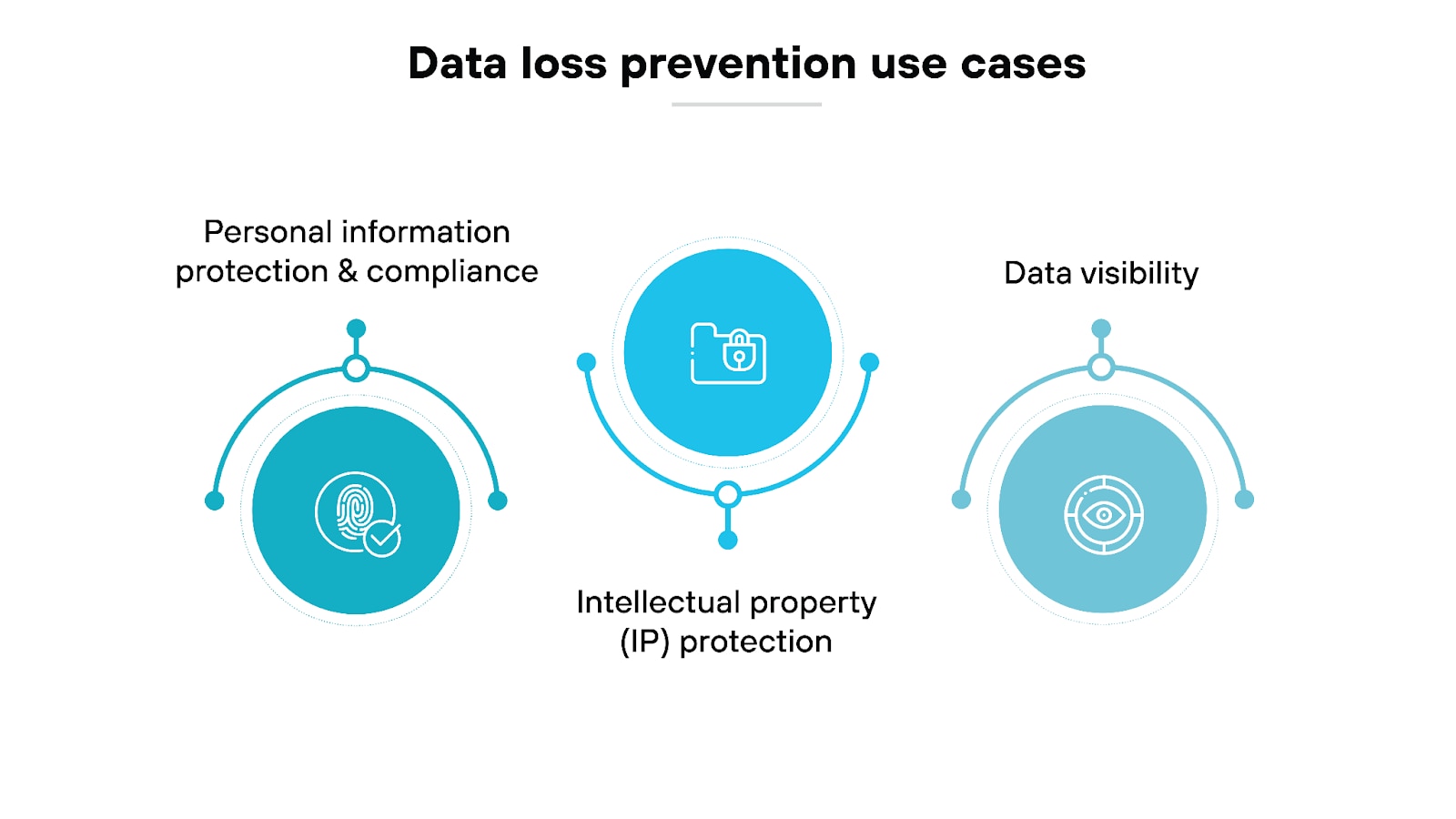
The three primary DLP use cases are personal information protection and compliance, intellectual property (IP) protection, and data visibility.
Let's explore the primary use cases where DLP proves valuable in maintaining security and compliance.
Personal information protection and compliance
One major use case for DLP is protecting personal information and ensuring compliance.
Organizations that handle sensitive data, such as PII or Protected Health Information (PHI), are often subject to strict regulations like GDPR or HIPAA. DLP solutions help identify, classify, and monitor these sensitive data types, reducing the risk of unauthorized access or accidental exposure. Reporting capabilities also make compliance audits easier.
Intellectual property (IP) protection
Another key use case for DLP is safeguarding intellectual property.
Organizations often possess valuable trade secrets and proprietary information that, if compromised, could harm their competitive edge or financial stability.
DLP tools use classification policies to protect this sensitive information from unauthorized access and prevent it from leaving the organization's boundaries.
Data visibility
DLP solutions are also vital for providing visibility into how data moves within an organization.
Businesses need insight into how data is accessed, shared, and stored across endpoints, networks, and cloud environments.
By monitoring data movement, DLP solutions provide a clear view of potential vulnerabilities and help ensure that sensitive information is not exposed to unauthorized individuals.
How to successfully adopt and deploy DLP in 7 steps

Successfully adopting and deploying a data loss prevention solution involves a series of methodical steps to ensure the system is integrated effectively.
Here, we break down each step to help you make the most of your DLP solution.
Step 1: Define business requirements
Before deploying a DLP solution, it’s important to start by defining your organization’s specific business requirements. Understanding what you need to achieve with DLP will guide the rest of the deployment.
Are you looking to protect intellectual property, meet compliance standards, or gain better data visibility?
Defining these objectives helps ensure that your DLP implementation meets your organization’s unique needs.
Step 2: Assess your existing infrastructure
Next, conduct a thorough assessment of your existing infrastructure.
Knowing where your data resides, how it’s being transmitted, and which systems are involved will help shape your DLP deployment strategy.
This step ensures that you have full visibility of your data environment, allowing you to tailor your DLP solution to cover all endpoints and data storage points effectively.
Step 3: Classify data by sensitivity
Data classification is a critical step in the deployment process.
To protect your data effectively, you first need to understand what kind of data you’re dealing with.
Classify data according to its sensitivity—for example, distinguishing between personal data, financial records, and intellectual property. This helps prioritize protection efforts and ensures that sensitive information is adequately safeguarded.
Step 4: Define roles and responsibilities
Establishing clear roles and responsibilities is crucial for a successful DLP deployment.
Determine who will be accountable for each aspect of the DLP solution, such as implementation, monitoring, and response to incidents.
This ensures that everyone knows their responsibilities, reducing confusion and the risk of oversights.
Tip: Make sure the roles are separate to provide checks and balances, especially when it comes to creating and implementing policies.
Step 5: Develop a deployment plan
With the foundational steps in place, it’s time to create a detailed deployment plan.
Outline the steps for installing, configuring, and testing the DLP solution. Include timelines, milestones, and any dependencies.
This plan serves as a roadmap to help minimize disruptions to business operations and ensures that the deployment proceeds smoothly.
Step 6: Document the process
Documentation is key to any successful deployment.
Document every aspect of the deployment process, including the steps taken, configurations made, and procedures established.
This serves not only as a reference for your IT and security teams but also as valuable material for training new employees and conducting compliance audits.
Step 7: Regularly test and review
DLP deployment doesn’t end once the solution is up and running.
Regular testing and review are essential to ensure that the system is working as expected and adapting to changes in the business environment.
Schedule regular assessments of your DLP setup, and adjust configurations as needed to maintain optimal performance. This ensures your DLP solution evolves alongside your organization and continues to effectively safeguard your data.
Further reading: Why a Comprehensive Approach to Data Security is Better than a Partial One
What is DLP’s role in compliance?
Data loss prevention plays an essential role in helping organizations meet regulatory compliance standards.
Compliance with industry standards and regulations is crucial for avoiding penalties and protecting an organization's reputation. DLP solutions help organizations meet these compliance requirements by securing sensitive information, controlling access, and ensuring transparency throughout data handling processes.
Many industries, such as healthcare, finance, and government contractors, are subject to strict regulations that require them to protect sensitive information. DLP solutions provide the tools and processes needed to comply with these regulations.
The compliance-related activities which DLP impacts are as follows:
Protecting sensitive data
Compliance regulations like GDPR, HIPAA, and PCI DSS require organizations to secure sensitive data. This includes PII, PHI, and financial data.
DLP tools help organizations identify, classify, and secure sensitive information, ensuring that it is not inadvertently shared or accessed by unauthorized users.
Preventing unauthorized data access
A critical aspect of compliance is controlling access to sensitive data.
Regulations often mandate that only authorized personnel can access specific types of information. DLP solutions enable organizations to enforce access controls and prevent unauthorized users from viewing, modifying, or transferring sensitive data.
This helps mitigate risks and ensures compliance with data protection laws.
Ensuring data visibility
Maintaining visibility into how data moves through an organization is another important compliance requirement.
DLP solutions provide comprehensive monitoring of data at rest, in motion, and in use. By tracking data across networks, endpoints, and cloud environments, organizations gain a clear understanding of how their sensitive information is being handled, which helps them stay compliant.
Supporting compliance audits
DLP solutions also simplify the audit process.
Regulations like GDPR and PCI DSS require organizations to demonstrate that they have adequate data protection measures in place.
DLP tools generate reports that detail how sensitive data is managed and protected, making it easier to provide the necessary evidence during compliance audits.
2024 data loss prevention statistics
- In 2023, exploitation of software vulnerabilities was the most common initial access method, making up 38.6% of incidents.
- In 93% of incidents responded to by Unit 42 in 2023, threat actors took data indiscriminately rather than searching for specific data.
- In 2022 and 2023, the median time to data exfiltration for non-extortion matters was less than one day.
- Palo Alto Networks Unit 42 Incident Response Report 2024 - With Palo Alto Networks, organizations can expect to reduce the likelihood of a data breach by up to 50% after three years. An equal attribution between NGFWs, CDSS, and Prisma SASE is applied at 33% each.
- Total Economic Impact™ of Palo Alto Networks CDSS - The global average cost of a data breach increased by 10% to USD 4.88 million from USD 4.45 million in 2023.
- 35% of breaches involved shadow data. Breaches involving shadow data resulted in a 16% greater cost, reaching an average of USD 5.27 million. Shadow data-related breaches took longer to identify and contain, with an average lifecycle of 291 days, which is 24.7% longer compared to breaches without shadow data.
- Organizations using AI and automation extensively in prevention saved an average of USD 2.2 million compared to those without these tools.
- 46% of breaches involved customer PII.
- The cost per record of compromised intellectual property (IP) data increased to USD 173 from USD 156 last year.
- More than half of breached organizations faced security staffing shortages, with a 26.2% growth in the skills gap compared to the prior year. This correlated with an average of USD 1.76 million more in breach costs.
- IBM Cost of a Data Breach Report 2024 - 54% of organizations have experienced an increase in the volume of cyberattacks in the past 12 months, with data exfiltration and insider threats being significant risks.
- 74% of organizations experienced data exfiltration following a ransomware attack.
- In a 2022 security survey, respondents cited network and email as primary use cases for DLP. Over 45% of organizations are looking to expand or upgrade their DLP coverage, mainly focusing on email and cloud environments.
- 78% of organizations are adjusting operations or changing their IT strategies due to concerns around data sovereignty.
- With the rise of hybrid work, 47% of organizations are concerned about the risk of sensitive information being accessed or saved on unmanaged devices.
- 62% of survey respondents classify general email messages as either very or extremely sensitive, while 52% report that email leakage of sensitive data is likely or very likely in their organization.
- IDC Adaptive Enterprise Data Loss Prevention in an Emerging Digital-First World - The role of state Chief Information Security Officers (CISOs) in maintaining data privacy has expanded significantly, jumping from 60% in 2022 to 86% in 2024. This reflects growing responsibilities for CISOs in managing and protecting sensitive citizen data amidst heightened privacy regulations. As of 2024, 20 states have comprehensive data privacy laws in effect, adding more responsibilities for CISOs to ensure compliance.
- AI-enabled threats are a major concern, with 71% of CISOs characterizing the threat level as "very high" or "somewhat high." AI and generative AI (gen AI) are viewed as increasing the sophistication and accessibility of cyberattacks, such as phishing using deepfakes. CISOs see both challenges and opportunities in leveraging AI for security, with 43 states expected to use gen AI to improve security operations within the next year.
- AI-enabled threats rank as the second most concerning form of cyber threat, trailing only third-party security breaches. These concerns are even higher than threats like foreign state-sponsored espionage and malware/ransomware.
- 2024 Deloitte-NASCIO Cybersecurity Study
2024 data loss prevention trends
- Traditional, content-heavy DLP measures are no longer sufficient to meet the dynamic data security needs of modern organizations.
Security and risk management leaders are increasingly seeking adaptive data protection techniques that include content and contextual inspection capabilities. This trend shows a shift towards more risk-based and adaptive data protection. - DLP projects that are not tied to specific initiatives or goals often reflect an immature data governance program, which can lead to inconsistent use cases and ultimately impact the success of selecting and implementing DLP technology.
- The convergence of DLP solutions with insider risk management (IRM) capabilities is enabling better detection of data exfiltration by enriching DLP events with anomalous user behavior and real-time monitoring.
This evolution helps security teams differentiate between malicious and accidental data disclosure. - Organizations with cloud-first strategies are increasingly choosing cloud-native DLP solutions that provide similar capabilities to enterprise DLP (EDLP) vendors, including SaaS and public cloud data security.
This trend is driven by the need to gain better visibility and control over data residing in cloud environments. - Behavioral-based DLP vendors are adopting an adaptive, risk-based approach by assigning a risk score to users based on factors such as their role, sensitivity of the data, and severity of activity.
This helps prioritize response efforts, focusing on more critical risks first. - Cloud data protection tools with agentless monitoring capabilities are being used to address multicloud environments, known as data security posture management (DSPM).
Currently, DSPM lacks the capability to perform remediation actions, and its primary focus does not include data exfiltration scenarios. - DLP is increasingly included as a capability in various security products, such as email security solutions, security service edge (SSE), and endpoint protection platforms (EPPs).
Integrated DLP capabilities have improved significantly, making them a viable option for organizations looking for a more consolidated solution. - Email is one of the most common channels for sending sensitive information, and many email security solutions now offer DLP features.
These include preventing accidental data loss, such as sending emails to unintended recipients, through the use of AI-based algorithms. - Endpoint DLP works via agents on user endpoints, focusing on data-in-use and data-at-rest scenarios, such as data leakage through USB drives or preventing sensitive information from being copied to the clipboard.
However, traditional endpoint DLP struggles with unmanaged endpoints in bring-your-own-device (BYOD) environments. - The integration of DLP with IRM provides a user-centric view, enabling easier differentiation between malicious and accidental acts of data disclosure.
This convergence reduces false positives and provides a better overall understanding of user behavior.
- Gartner 2023 Market Guide for Data Loss Prevention - Modern DLP has shifted from a static model to a dynamic, risk-adaptive approach. This involves leveraging machine learning (ML) to adapt to changing data patterns, enhancing scalability, and enabling user-centric policies based on behavior analytics.
- User behavior analytics (UBA) is increasingly integrated into DLP to enhance user-centric visibility and reduce false positives. This convergence of DLP with insider risk management helps organizations identify and mitigate insider threats more accurately.
- IDC Adaptive Enterprise Data Loss Prevention in an Emerging Digital-First World - Generative AI (GenAI) can be effectively used to automate the handling of noisy Data Loss Prevention (DLP) alerts. These alerts often require significant manual intervention by analysts, such as reviewing the files for sensitive information, checking the user’s role, and identifying trends from past alerts.
- The traditional workflow for handling DLP alerts involves several steps that can be automated using GenAI.
These steps include creating tickets, populating relevant data, reviewing file content, assessing the user’s role, and analyzing previous alerts. By leveraging GenAI for these repetitive tasks, SOC teams can focus on higher-value activities and reduce the manual burden. - It is common for certain users, such as individuals in enterprise accounts, to trigger repeated DLP alerts. This often leads to these users being internally identified as having routine alert patterns.
However, the automatic dismissal of alerts carries risks, and GenAI can help determine if these incidents represent actual policy violations or expected behavior. - GenAI can assist in summarizing DLP alert information for security analysts.
This includes pulling details such as previous ticket history, file content, user role, and past alerts to generate a comprehensive summary. The automation can save time for analysts, but the output should still be verified by a human to ensure accuracy. - Even though a human analyst should review GenAI-generated output, leveraging GenAI for DLP alerts can lead to significant operational efficiencies in the SOC. This is particularly relevant for organizations dealing with high alert volumes and repetitive DLP investigations.
- Practical Applications of GenAI in a SOC, SANS
Top 10 DLP best practices, tips, and tricks
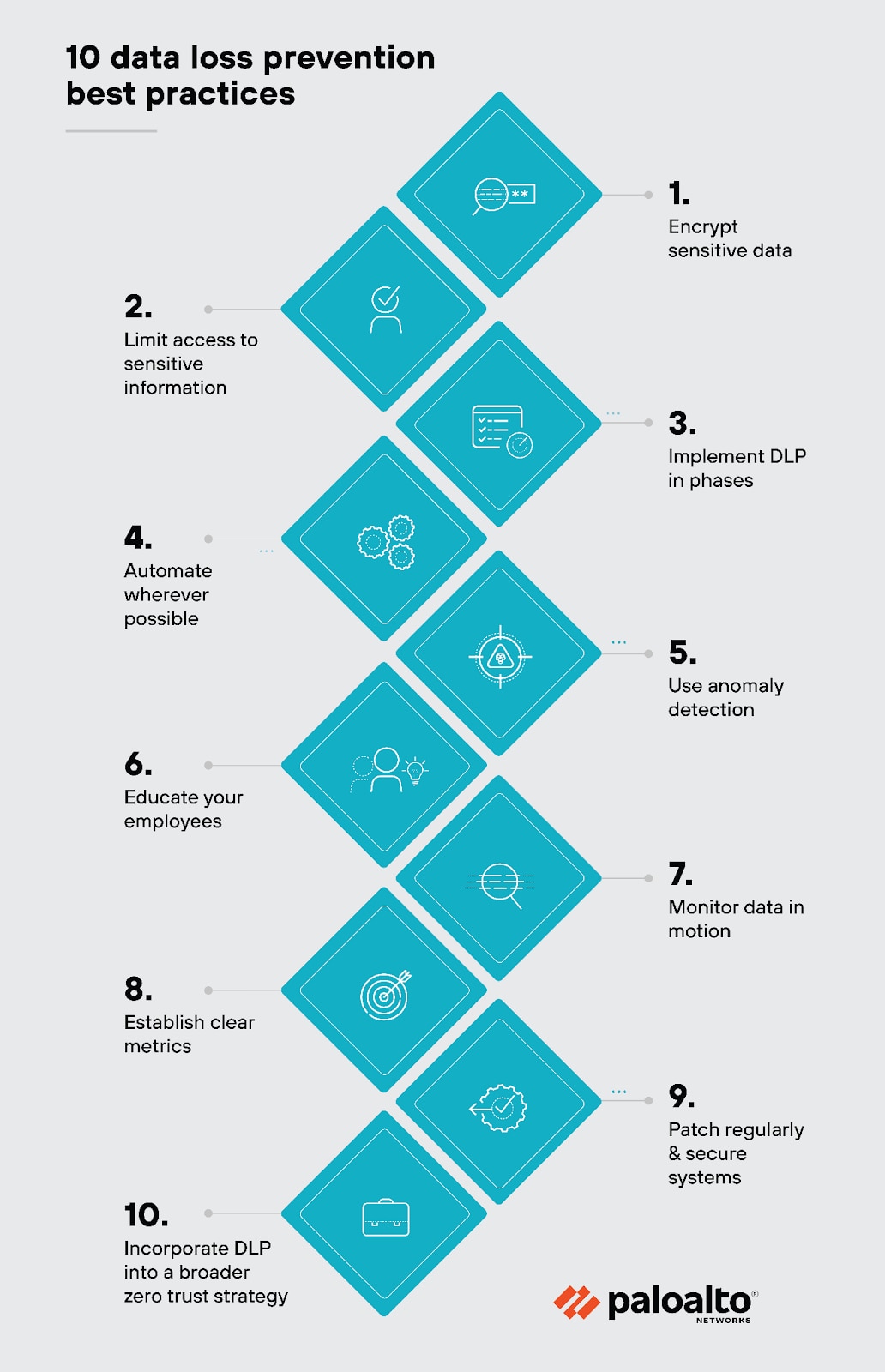
Implementing data loss prevention effectively requires more than just deploying a tool.
Following best practices can help ensure that your DLP strategy is strong, scalable, and effective at preventing sensitive data from slipping through the cracks.
Here are ten key DLP best practices to consider:
1. Encrypt sensitive data
One of the best ways to protect your data is to encrypt it—whether at rest or in transit.
Encryption ensures that unauthorized users can’t view the file content even if they gain access. It adds an important layer of security and helps maintain compliance with data privacy regulations.
2. Limit access to sensitive information
Not everyone in your organization needs access to all data. Only grant permissions to those who require them for their roles.
This practice, often called the principle of least privilege, minimizes the risk of accidental or intentional data loss by reducing the number of individuals who can access sensitive information.
3. Implement DLP in phases
Rolling out DLP in phases allows you to evaluate the system’s effectiveness gradually.
Start with a pilot test to understand how the DLP solution fits with your organization's processes.
Then, expand its use in stages, refining as needed. This approach ensures smoother adoption and reduces disruptions.
4. Automate wherever possible
Manual data protection processes often fall short due to limited scalability.
Automate DLP processes, like data discovery and anomaly detection, to quickly and consistently enforce security policies.
Automation helps your organization stay ahead of potential threats, especially as data grows in volume and complexity.
5. Use anomaly detection
DLP solutions that integrate machine learning and behavioral analytics are better equipped to detect abnormal activities that might signal a data breach.
Anomaly detection can help identify unauthorized data movement or suspicious user behavior before it leads to a major security incident.
6. Educate your employees
A DLP policy isn’t effective if your stakeholders and employees aren’t aware of it.
Regular training helps ensure that everyone understands the role they play in data security. Make sure to educate your team about what constitutes risky behavior and how they can avoid unintentional data breaches.
7. Monitor data in motion
Monitoring data in transit is critical for ensuring sensitive information isn’t shared outside authorized channels.
Keeping an eye on data being transmitted—via email, messaging platforms, or other networks—helps identify and prevent accidental or malicious data leaks.
8. Establish clear metrics
Set measurable metrics, such as the number of incidents, response times, and reduction in false positives, to evaluate the effectiveness of your DLP solution.
Metrics help identify gaps and justify further investments or changes in the strategy. They also provide a clear benchmark for communicating the value of DLP initiatives to leadership.
9. Patch regularly and secure systems
A network is only as secure as its weakest link.
Make sure all systems connected to sensitive data are up to date with the latest patches. A robust patch management strategy reduces vulnerabilities that attackers might exploit to bypass your DLP controls.
10. Incorporate DLP into a broader zero trust strategy
DLP works best as part of a larger zero trust approach to security.
Don’t inherently trust any device or user—always verify identity and clearance. Combining zero trust with DLP ensures that sensitive data access is tightly controlled and constantly verified, reducing the likelihood of data loss.
DLP FAQs
The DLP meaning in cyber security is an approach aimed at preventing unauthorized access, use, or transmission of sensitive information.
In network security, DLP is a strategy for preventing unauthorized access, transfer, or destruction of sensitive data. It involves tools and processes to monitor data in motion, at rest, and in use to prevent data breaches.
DLP security refers to data loss prevention security measures that protect sensitive data from unauthorized access, misuse, or loss. It involves monitoring and managing data at rest, in use, or in transit to prevent data breaches, ensuring compliance with regulations, and safeguarding confidential information against cyber threats.
DLP solutions identify, monitor, and protect sensitive data. They prevent unauthorized sharing or exposure of information by enforcing policies on data movement and use, enhancing data security and regulatory compliance.
The three types of DLP are network DLP (protects data in transit across networks), endpoint DLP (secures data on user devices), and cloud DLP (protects data in cloud environments).
The DLP process involves identifying sensitive data, defining data security policies, monitoring data movement, enforcing rules to prevent data breaches, and responding to incidents to maintain data integrity and security.
DLP implementation risks include false positives, system performance issues, complexity in policy configuration, and privacy concerns over employee data monitoring.
An example of loss prevention is encrypting sensitive information being sent via email to prevent unauthorized users from accessing it even if they intercept the data.
DLP is used by implementing tools to monitor data flow, applying encryption, setting up user access controls, and creating policies to restrict unauthorized data sharing.
Companies need DLP to prevent data breaches, comply with regulations, protect sensitive information like intellectual property, and maintain customer trust by ensuring data privacy.
The five parts of a DLP solution are securing data in motion, securing data at rest, securing data in use, data identification and classification, and data leak detection.
An example of DLP is endpoint DLP software that prevents employees from copying sensitive data to external storage devices like USB drives.
DLP (Data Loss Prevention) refers to tools and strategies used to keep sensitive information from being lost, leaked, or accessed by unauthorized users.
Data leak detection is the DLP component responsible for investigation, as it monitors for suspicious data transfers and alerts administrators for further action.
Data loss protection refers to safeguarding sensitive data from being lost or destroyed, often due to malicious attacks, human errors, or technical failures.
A DLP system is a set of tools and policies designed to prevent unauthorized access, movement, or destruction of sensitive data, thereby securing an organization's critical information.